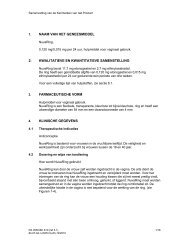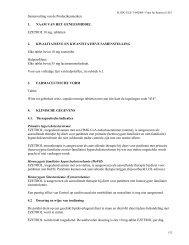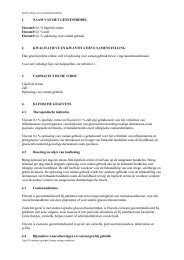Drug Drug Interactions with VICTRELIS® (boceprevir) Informative ...
Drug Drug Interactions with VICTRELIS® (boceprevir) Informative ...
Drug Drug Interactions with VICTRELIS® (boceprevir) Informative ...
Create successful ePaper yourself
Turn your PDF publications into a flip-book with our unique Google optimized e-Paper software.
1. NAME OF THE MEDICINAL PRODUCT Victrelis 200 mg hard capsules 2. QUALITATIVE AND<br />
QUANTITATIVE COMPOSITION Each hard capsule contains 200 mg of <strong>boceprevir</strong>. Excipient <strong>with</strong> known<br />
effect: each capsule contains 56 mg of lactose monohydrate. For the full list of excipients, see section 6.1.<br />
3. PHARMACEUTICAL FORM Hard capsule. Each capsule has a yellowish-brown, opaque cap <strong>with</strong> an<br />
“MSD” logo imprinted in red ink and off-white, opaque body <strong>with</strong> the code “314” imprinted in red ink.<br />
4. CLINICAL PARTICULARS 4.1 Therapeutic indications Victrelis is indicated for the treatment of chronic<br />
hepatitis C (CHC) genotype 1 infection, in combination <strong>with</strong> peginterferon alfa and ribavirin, in adult patients<br />
<strong>with</strong> compensated liver disease who are previously untreated or who have failed previous therapy. See<br />
sections 4.4 and 5.1. 4.2 Posology and method of administration Treatment <strong>with</strong> Victrelis should be initiated<br />
and monitored by a physician experienced in the management of chronic hepatitis C. Posology Victrelis must<br />
be administered in combination <strong>with</strong> peginterferon alfa and ribavirin. The Summary of Product Characteristics<br />
of peginterferon alfa and ribavirin (PR) must be consulted prior to initiation of therapy <strong>with</strong> Victrelis. The<br />
recommended dose of Victrelis is 800 mg administered orally three times daily (TID) <strong>with</strong> food (a meal or light<br />
snack). Maximum daily dose of Victrelis is 2,400 mg. Administration <strong>with</strong>out food could be associated <strong>with</strong> a<br />
net loss of efficacy due to sub-optimal exposure. Patients <strong>with</strong>out cirrhosis who are previously untreated or<br />
who have failed previous therapy The following dosing recommendations differ for some subgroups from the<br />
dosing studied in the Phase 3 trials (see section 5.1). Table 1 Duration of therapy using Response-Guided<br />
Therapy (RGT) guidelines in patients <strong>with</strong>out cirrhosis who are previously untreated or who have failed<br />
previous therapy to interferon and ribavirin therapy Previously Untreated Patients ASSESSMENT* (HCV-RNA<br />
Results † ) At Treatment Week 8 Undetectable At Treatment Week 24 Undetectable ACTION Treatment<br />
duration = 28 weeks 1. Administer peginterferon alfa and ribavirin for 4 weeks, and then 2. Continue <strong>with</strong> all<br />
three medicines (peginterferon alfa and ribavirin [PR] + Victrelis) and finish through Treatment Week 28 (TW<br />
28). Previously Untreated Patients ASSESSMENT* (HCV-RNA Results † ) At Treatment Week 8 Detectable At<br />
Treatment Week 24 Undetectable ACTION Treatment duration = 48 weeks ‡ 1. Administer peginterferon alfa<br />
and ribavirin for 4 weeks, and then 2. Continue <strong>with</strong> all three medicines (PR + Victrelis) and finish through TW<br />
36; and then 3. Administer peginterferon alfa and ribavirin and finish through TW 48. Patients Who have<br />
Failed Previous Therapy ASSESSMENT* (HCV-RNA Results † ) At Treatment Week 8 Undetectable At Treatment<br />
Week 24 Undetectable or At Treatment Week 8 Detectable At Treatment Week 24 Undetectable ACTION<br />
Treatment duration = 48 weeks 1. Administer peginterferon alfa and ribavirin for 4 weeks, and then 2.<br />
Continue <strong>with</strong> all three medicines (PR + Victrelis) and finish through TW 36, and then 3. Administer<br />
peginterferon alfa and ribavirin and finish through TW 48. *Stopping rule If the patient has hepatitis C virus<br />
ribonucleic acid (HCV-RNA) results greater than or equal to 100 IU/ml at TW 12; then discontinue threemedicine<br />
regimen. If the patient has confirmed, detectable HCV-RNA at TW 24; then discontinue threemedicine<br />
regimen. † In clinical trials, HCV-RNA in plasma was measured <strong>with</strong> the Roche COBAS Taqman 2.0<br />
assay <strong>with</strong> a limit of detection of 9.3 IU/ml and a limit of quantification of 25 IU/ml. ‡ This regimen has only<br />
been tested in subjects who have failed previous therapy who were late responders (see section 5.1). All<br />
cirrhotic patients and null responders: Recommended treatment duration is 48 weeks: 4 weeks of bitherapy<br />
<strong>with</strong> peginterferon alfa+ ribavirin + 44 weeks of tritherapy <strong>with</strong> peginterferon alfa + ribavirin + Victrelis. (Refer<br />
to the stopping rule in Table 1 for all patients.) The duration of the tritherapy after the first 4 weeks of<br />
bitherapy should not be less than 32 weeks. Given the incremental risk of adverse events <strong>with</strong> Victrelis<br />
(anaemia notably); in case the patient cannot tolerate the treatment, consideration could be given to pursue<br />
<strong>with</strong> 12 weeks of bitherapy for the final 12 weeks of treatment instead of tritherapy (see sections 4.8 and 5.1).<br />
Missed doses If a patient misses a dose and it is less than 2 hours before the next dose is due, the missed<br />
dose should be skipped. If a patient misses a dose and it is 2 or more hours before the next dose is due, the<br />
patient should take the missed dose <strong>with</strong> food and resume the normal dosing schedule. Dose reduction<br />
Dose reduction of Victrelis is not recommended. If a patient has a serious adverse reaction potentially related<br />
to peginterferon alfa and/or ribavirin, the peginterferon alfa and/or ribavirin dose should be reduced. Refer<br />
to the Summary of Product Characteristics for peginterferon alfa and ribavirin for additional information<br />
about how to reduce and/or discontinue the peginterferon alfa and/or ribavirin dose. Victrelis must not be<br />
administered in the absence of peginterferon alfa and ribavirin. Special populations Renal impairment No<br />
34<br />
dose adjustment of Victrelis is required in patients <strong>with</strong> any degree of renal impairment (see section 5.2).<br />
Hepatic impairment No dose adjustment of Victrelis is required for patients <strong>with</strong> mild, moderate or severe<br />
hepatic impairment. Victrelis has not been studied in patients <strong>with</strong> decompensated cirrhosis (see section<br />
5.2). Paediatric population The safety and efficacy of Victrelis in children aged below 18 years have not yet<br />
been established. No data are available. Elderly Clinical studies of Victrelis did not include sufficient numbers<br />
of subjects aged 65 and over to determine whether they respond differently from younger subjects. Other<br />
clinical experience has not identified differences in responses between the elderly and younger patients (see<br />
section 5.2). Method of administration To obtain the hard capsules the foil of the blister should be peeled off.<br />
Victrelis is to be taken orally <strong>with</strong> food (a meal or light snack). 4.3 Contraindications Victrelis, in combination<br />
<strong>with</strong> peginterferon alfa and ribavirin, is contraindicated in: Patients <strong>with</strong> hypersensitivity to the active<br />
substance or any of the excipients listed in section 6.1. Patients <strong>with</strong> autoimmune hepatitis. Co-administration<br />
<strong>with</strong> medicines that are highly dependent on CYP3A4/5 for clearance, and for which elevated plasma<br />
concentrations are associated <strong>with</strong> serious and/or life-threatening events such as orally administered<br />
midazolam and triazolam, bepridil, pimozide, lumefantrine, halofantrine, tyrosine kinase inhibitors,<br />
simvastatin, lovastatin, and ergot derivatives (dihydroergotamine, ergonovine, ergotamine, methylergonovine)<br />
(see section 4.5). Pregnancy (see section 4.6). Refer to the Summary of Product Characteristics for<br />
peginterferon alfa and ribavirin for additional information. 4.8 Undesirable effects The safety profile<br />
represented by approximately 1,500 patients for the combination of Victrelis <strong>with</strong> peginterferon alfa 2b and<br />
ribavirin was based on pooled safety data in two clinical trials: one in patients who were previously untreated,<br />
and one in patients who had failed prior therapy (see section 5.1). The most frequently reported adverse<br />
reactions were fatigue, anaemia (see section 4.4), nausea, headache, and dysgeusia. The most common<br />
reason for dose reduction was anaemia, which occurred more frequently in subjects receiving the combination<br />
of Victrelis <strong>with</strong> peginterferon alfa 2b and ribavirin than in subjects receiving peginterferon alfa 2b and<br />
ribavirin alone. Adverse reactions are listed by System Organ Class (see Table 3). Within each system organ<br />
class, adverse reactions are listed under headings of frequency using the categories: very common (≥ 1/10);<br />
common (≥ 1/100 to < 1/10); uncommon (≥ 1/1,000 to < 1/100); rare (≥ 1/10,000 to < 1/1,000); not known<br />
(cannot be estimated from the available data). Table 3 Adverse reactions in combination <strong>with</strong> Victrelis <strong>with</strong><br />
peginterferon alfa 2b and ribavirin reported during clinical trials † and ‡ System Organ Class Infections and<br />
infestations Adverse Reactions Common: Bronchitis*, cellulitis*, herpes simplex, influenza, oral fungal<br />
infection, sinusitis Uncommon: Gastroenteritis*, pneumonia*, staphylococcal infection*, candidiasis, ear<br />
infection, fungal skin infection, nasopharyngitis, onychomycosis, pharyngitis, respiratory tract infection,<br />
rhinitis, skin infection, urinary tract infection Rare: Epiglottitis*, otitis media, sepsis System Organ Class<br />
Neoplasms benign, malignant and unspecified (including cysts and polyps) Adverse Reactions Rare: Thyroid<br />
neoplasm (nodules) System Organ Class Blood and lymphatic system disorders Adverse Reactions Very<br />
common: Anaemia*, neutropenia* Common: Leukopenia*, thrombocytopenia* Uncommon: Haemorrhagic<br />
diathesis, lymphadenopathy, lymphopenia Rare: Haemolysis System Organ Class Immune system disorders<br />
Adverse Reactions Rare: Sarcoidosis*, porphyria non-acute System Organ Class Endocrine disorders Adverse<br />
Reactions Common: Goitre, hypothyroidism Uncommon: Hyperthyroidism System Organ Class Metabolism<br />
and nutrition disorders Adverse Reactions Very common: Decreased appetite* Common: Dehydration*,<br />
hyperglycaemia*, hypertriglyceridaemia, hyperuricaemia Uncommon: Hypokalaemia*¸ appetite disorder,<br />
diabetes mellitus, gout, hypercalcaemia System Organ Class Psychiatric disorders Adverse Reactions Very<br />
common: Anxiety*, depression*, insomnia, irritability Common: Affect lability, agitation, libido disorder,<br />
mood altered, sleep disorder Uncommon: Aggression*, homicidal ideation*, panic attack*, paranoia*,<br />
substance abuse*, suicidal ideation*, abnormal behaviour, anger, apathy, confusional state, mental status<br />
changes, restlessness Rare: Bipolar disorder*, completed suicide*, suicide attempt*, hallucination auditory,<br />
hallucination visual, psychiatric decompensation System Organ Class Nervous system disorders Adverse<br />
Reactions Very common: Dizziness*, headache* Common: Hypoaesthesia*, paraesthesia*, syncope*,<br />
amnesia, disturbance in attention, memory impairment, migraine, parosmia, tremour, vertigo Uncommon:<br />
Neuropathy peripheral*, cognitive disorder, hyperaesthesia, lethargy, loss of consciousness, mental<br />
impairment, neuralgia, presyncope Rare: Cerebral ischaemia*, encephalopathy System Organ Class Eye





